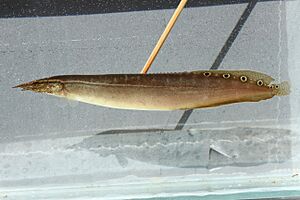Peacock eel facts for kids
Quick facts for kids Peacock eel |
|
|---|---|
 |
|
| Peacock eel from Nakhon Phanom, Thailand | |
 |
|
| Peacock spiny eel from Miami-Dade County, Florida | |
| Conservation status | |
| Scientific classification | |
| Synonyms | |
|
The peacock eel (also called the spotfin spiny eel) is a cool type of spiny eel. You can find them living in freshwater places all over Southeast Asia. People sometimes catch them for food or keep them as pets in aquariums.
Contents
Where Do Peacock Eels Live?
Peacock eels originally come from rivers in Southeast Asia. They live in the Mekong and Chao Phraya river systems. These rivers flow through countries like Thailand, Cambodia, Laos, and Vietnam.
These eels love slow-moving water. You can often find them in places with sandy or muddy bottoms. They live in swamps, canals, and ponds.
Peacock Eels in Florida
Sometimes, peacock eels end up in new places. There is now a group of them living in Florida, in the Everglades area. They probably got there because people released them from their home aquariums.
Scientists first found these eels in a canal in 2002. By 2004, they were also living in the mangrove swamps further south. When animals move to new places and cause problems, they are called invasive species.
What Do Peacock Eels Look Like?
Peacock eels do not have scales like many other fish. They need soft ground to burrow into. They like to dig into sand, mud, or soft dirt.
These eels can grow up to 30 centimeters (about 12 inches) long. However, it's more common to see them around 20 centimeters (about 8 inches). It's very hard to tell male and female eels apart just by looking at them.
Peacock Eel Life Cycle
Peacock eels lay their eggs during the wet season. This is when nearby forests get flooded with water. Young eels grow quickly. They can reach about 8 centimeters (3 inches) long in just 60 days after they hatch.
What Do Peacock Eels Eat?
Peacock eels are carnivores, which means they eat other animals. Their favorite foods include small crustaceans (like tiny crabs or shrimp). They also enjoy eating annelids (which are segmented worms) and small fish.


